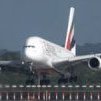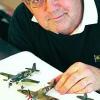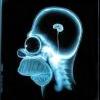

fastterry
Members-
Posts
174 -
Joined
-
Last visited
Profile Information
-
Gender
Male
-
Location
Perth, Western Australia
Recent Profile Visitors
889 profile views
fastterry's Achievements

New Member (2/9)
172
Reputation
-
I had a bit of depression come over me when I read about some other supposed inaccuracies of the Eduard 109s as I have about 8 or so in the stash. I knew about the ballsup with the original tooling and that there was a couple of left overs ie the exhaust and the uc legs. I have a Hasegawa and Tamiya 109G-6 built along with a Eduard G-14. Running my trusty micrometer over all three I came up with the following figures. All were measured at the trailing edge of the wing from the bottom of the fuselage to the top of the canopy. The Hasegawa and the Tamiya were almost identical at 27.6mm whilst the Eduard G-14 was 28.3mm. That makes a difference of 0.7mm which would be 1.05mm taller in 1/32 if Tamiya made a 1/32 G-6. I think that is not worth worrying about in the scheme of things. I personally think that Eduard would be mad to do the late war 109s and Fw190s in 1/32 as there are a number of state of the art kits available as competition. I can see the rational for them doing a Spitfire IX as the Czechs flew them at the end of the war and into peacetime. Earlier Merlin Spitfires will run into the proposed Kotare versions but as they are a long way from Europe and are not cheap Eduard should be ok there. As previously said by a number of people the MiG-21 and all its versions are a no brainer as Eduard obviously has lots of data on them. TRF
-
Just measured my unbuilt Mk 1, still in the box, and the dimensions are 5.2mm dia x 3.3mm high measured with a micrometer. TRF
-
I was typing this when the other replies came in. Some figures to ponder. A P-51D weighs 7.100lbs (3,227kgs) empty with normal loaded weight of 10.100lbs (4,590kgs) whereas an F-82 weighs 13,405lb (6,093kgs) with a normal loaded weight of 19,100lbs (8,682kgs) so virtually twice as heavy with still only having two main wheels. TRF
- 6 replies
-
- 1
-

-
- F-82 Twin Mustangm
- MLG wheels
-
(and 1 more)
Tagged with:
-
Bing! A light just came on in my tiny brain. All Luftwaffe fighters had three blade props of ever expanding width, as the engine power increased, and I always wondered why they never went to more blades. The Spitfire went from two to three, then four and finally five in the Griffon powered variants. I don't know if it's true but I did read somewhere that the German designers reckoned that propeller efficiency decreased after three blade arrangements. I did wonder about this as modern turbo prop aircraft have up to eight blades. Now it seams we have the answer. If they went to four or five blades the fuselage guns would hardly fire as there would always be a blade in the way, one of the major disadvantages of having fuselage mounted guns. Image the Fw190D-9 and the Ta152 with four or five blade props. Food for thought. TRF
-
Thanks very much for the replies, I think an application of dark grey on the outer half of the back face of the blades should do the trick. I think lots of modellers put a lot of effort into weathering the airframes and forget about propeller wear. TRF
-
I'm putting the finishing touches on a 1/32 Hasegawa Spitfire Vb dressed up in desert camo and I was wondering what the wear would look like on the back side of a propeller made from compressed wood. Obviously a metal blade made from aluminium or magnesium would have a showing of the metal underneath the paint from abrasion but what about the wooden prop. I know the leading edges of wooden props had metal strips to protect them but hadn't read anything about protecting the back side. Thoughts anyone. TRF
-

Question re: Quickboost details sets for Tamiya Bf.109G-6 kit
fastterry replied to Wm Blecky's topic in Aircraft WWII
The so called pistons are actually the hydraulic cylinder body and piston rod that operate on the uc leg to retract it into the wing. They are positioned inside the wing along the semi circular part of the wheel bay that runs from the base of the uc leg to the wheel well. Typically they can be seen through the four rectangular cutouts in the semi circular bit. Most kits only have an indication of these cutouts so you will have to drill them out if you want to see the retraction cylinders. Hardly worth the trouble in 1/72 in my humble opinion. TRF- 4 replies
-
- 2
-

-
- 1/72
- Tamiya Bf.109G-6
-
(and 1 more)
Tagged with:
-
It might be worth a visit to Large Scale Planes as a number of these kits have been built and posted on the site. Type in ZM 1/32 Ta152 builds Large Scale Planes and look for a modeller called Thunnus. It will either leave you inspired or cringing in the corner in the fetal position. TRF
- 21 replies
-
- 2
-

-

-
- Ta152H
- focke-wulf
-
(and 1 more)
Tagged with:
-
For what it's worth my tip is that both fins are the same. Great bit of Forensic Aviaeology going on here. TRF
-
Also note the 6 stack exhaust, not that common on Mk Vcs. Seems like this aircraft may have had some updates (wing stiffeners & exhaust). TRF
-
As GB says these are well used trainers. Combat aircraft, particularly in WW2 mostly had very short lives and the majority didn't get as dirty and faded as the ones above. Think about the fact that there were 22,000 Spitfires and 30,000 Bf109s built and there wasn't multiple thousands left at the end of the war. Apart from combat losses there was a large number lost in training and flying accidents. A lot of modellers point to the weathered and faded condition of German aircraft seen in photos that were taken after the war. What most don't realise is that in a lot of cases these were taken some time after the cessation of hostilities and had been out in the weather for months. My pet hate is the quilted weathering which seems to be favoured by modellers whom I suspect have never seen a real plane close up. My approach is a little bit of exhaust staining and maybe some oil streaks for most types (I build mostly fighters) and a bit heavier on the fading if the subject operated in the desert or the SWPO. YMMV. TRF
- 34 replies
-
- 15
-

-
Well the can of worms was definitely opened up here. I don't have a photo hosting service and I think if I sent you scans of the poor quality photos in the JaPo book they will not add much to your knowledge but if you are still interested send me a PM. TRF
-
Hi Kov, I have the two JaPo books and white 16 is on pages 273-275 of Vol 2. There is a photo of the port wing root area which does show a marked difference between the light and dark camo paint. Now as it is a black & white photo the light colour could be 76, faded 75 or even 77. There is another photo which shows the aircraft from the rear port quarter but the light has make the upper surfaces very difficult to make out any 'colours'. Having said that the port tailplane does show a clear demarcation. JaPo picked their colours on grading the grey hues of the photos and matching them to known colours as well as crash reports etc. I have built the Revell/Hasegawa brown 4 in 1/32 and the Eduard 1/48 black 6+1 ( the ones with the big fins) and have used 76/81 on the wings and I defy anyone to say I'm wrong because unless a colour photo shows up JaPo are just as liable to be right as anybody and it does make a nice change from the same old 74. 75. 76. I really think we modellers overthink the colour thing as it has been proven plenty of times even on modern jets etc that after a while they all weather differently and look slightly different even though they were supposed to be painted with the same paint/colour. 500666 appears on pages 280-282 with a couple of photos of the fuselage in a dump sans wings. The port tailplane is again visible in the second photo with strong light making the details indistinct but you can just make out a fairly strong contrast between the light and the dark camo. Bottom line is there are no clear photos of most of these late war D-9s to conclusively say this colour or that colour was used so you pays your money and makes your choice. Hth. TRF
-

1/35 - Supermarine Spitfire Mk.Vb by Border Model - released
fastterry replied to Homebee's topic in The Rumourmonger
This Trumpeter/Hobbyboss/Border thing has been a pet peeve of mine ever since they released the Bf109G series in 1/24 scale all those years ago. The 1/32 Trumpeter 109 kits had all the same errors as the bigger kits and the Border 109 has them also. The Hobbyboss 1/24 Spitfire has passed down it's errors to the 1/32 scale Spitfires and now down to the Border 1/35 scale Spit. Border did change the ribbed top surface on the tail planes which is a real surprise considering the Chinese conglomerates normal lack of interest in correcting any errors. The Stukas also have errors in 1/24 and 1/32 and 1/35 scale but from what I've seen the Fw190 looks like a decent kit. The one saving grace for Border is that the people who build targets etc in 1/35 won't know or care about the deficiencies in any of the Border aircraft kits because they will look close enough to the subject to fit into their dioramas. CAD & CAM can be a great thing if the information used to create the files is accurate, Where the Trumpeter conglomerate falls down is they don't have the desire/interest/budget to go back and correct the files and fix the errors so they are then perpetuated for as many times as they are used. TRF- 48 replies
-
- 1
-





